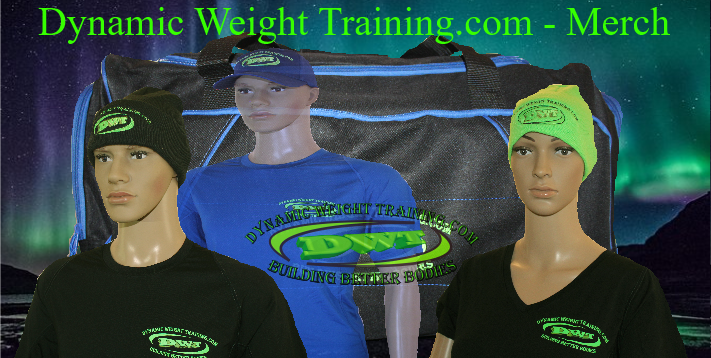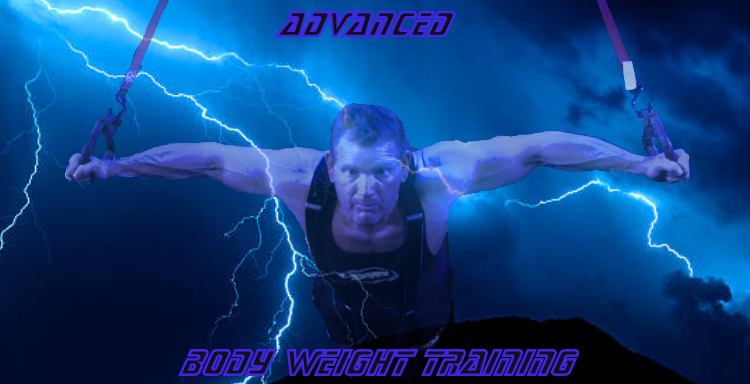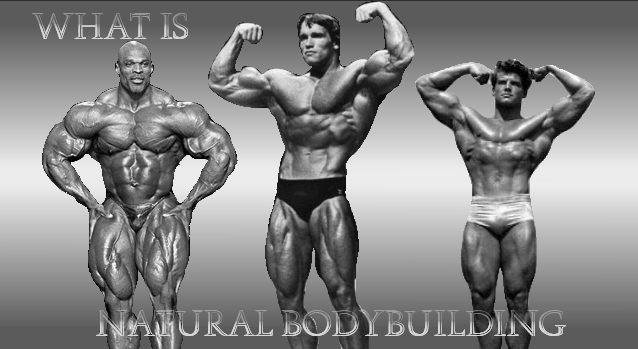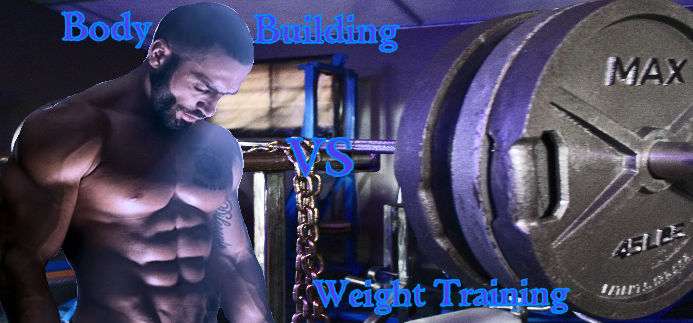AB Weight Training
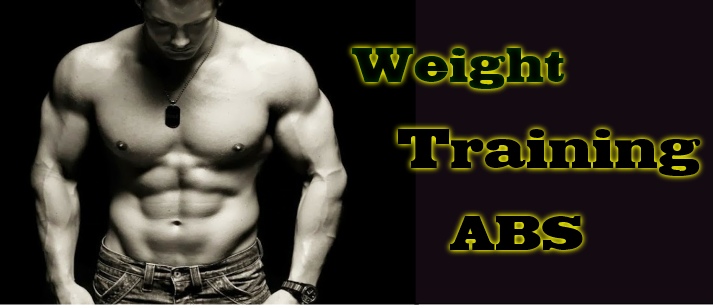
Almost no other body part seems to be as misunderstood as ab weight training. A strong and defined abdominal wall is the most coveted and talked about body part on the Planet…
all because this body part is immediately recognized as the epitome of good conditioning and athleticism. I would like to use this article to take some of the guesswork out of abdominal training.
Whether you use weights or bodily resistance, the abdominal's usually respond well, they don’t over train nearly as easily as other body parts as they are a higher density muscle group.
As you read on, you will further discover that ab weight training is a world unto itself, there are misconceptions about ab training and how to develop them so… lets remove some guesswork.
Myths of ab weight training
There are two types of people when it comes to ab training… There are the ones that talk about it, but never define and focus on a goal! You are 10 times more likely to succeed if you set a goal!
Then there are the types of people who set goals and go for them and these people bring from the shadows of obscurity, the realization of a beautiful set of abs that reflect back at them in the mirror and will forever change their lives.

Training the abdominal area and making it respond, at least in the West: seems to always be shrouded in an endless sea of information that winds up confusing most.
Developing the abdominal six-pack does take some effort and planning, but…
If you treat this muscle group and the ones that surround it like any other, you will see results, even fantastic ones, if you can stay consistent!
Myths and Facts on AB Training
Myths:
Most experts insist abdominal training comes at the end of the workout?
To the experts I say: let’s see your abs! Ab training is like any other body part, let your goal dictate what you want from your ab training. If better looking abs and a stronger core is your goal. Don’t let anyone tell you any different, go for it! And use all of the training exercises I show here and make them your new priority.
If I do nothing but abdominal exercises can see my abs?
Well… the answer to this is yes and no, if your body fat is lower, say; 12 or 13% or less, then yes; the defining work that you do will show, If your % is not this low, the abs won’t be as noticed visually!
Will I lose weight by just doing abdominal exercises?
Abdominal exercises on their own, burn very few calories, but... performing ab weight training exercises, will make the abdominal and surrounding area more pronounced and visually striking, if you keep an active metabolism and body fat levels in check.
Note: you may lose a small amount of weight if the exercises are done vigorously, but… Aerobic activity, high-intensity low-impact aerobics, a clean diet, along with this articles ab weight training exercises, will be the most responsible for bringing your abs out of obscurity.
How can you tell if your ab routine/training is working?
The core muscles, meaning: the abdominal's lower back and oblique’s should feel the fatigue or tenderness from the previous days exercise. Beginners will feel this sensation more intensely. My opinion on ab training is: when you can no longer feel training fatigue, it’s probably time to up intensity or change the routine.
How long and at what frequency should my ab weight training routine last?
If you’re a beginner and mildly out of shape, 10 -12 minutes at a steady pace would be plenty, performed 2 days a week... For an intermediate level athlete; try to keep your intensity, time and effort in and around the 12 - 15 minute mark. Intermediate or advanced levels, 3 to 4 times per week, monitor progress and regulate frequency as necessary.
As your abs become more conditioned, the frequency of abdominal discomfort will become less.
Defining your Abs is a cross-section of two things, first: a clean diet, to remove body fat, assuming you have that under control.
The second: and most important thing to define the abs is: using ab weight training or resistant to encourage abdominal growth and sharpen the abs and other surrounding core muscles.
Will using weights or resistant make my waist look bigger?
The abdominal and core muscle group is not designed to be huge! Ab weight training is designed to take your core training to the next level.
First we need to develop the abs with the use of resistance then we define and sharpen the look of your abs.
Note: a well developed abdominal wall probably has no more than a half-inch of protruding abdominal muscle, from that of someone that rarely trains them. So no; using weights simply: builds and accents the abs modestly, not the girth.
Why the abdominal journey takes so long?
Especially seen in men; belly fat and the love handles are the last-thing to go off the mid-section, which of course obscures the look of the abdominal's, this can often vary from genetics, hormones or metabolic imbalances.
Their are of course many different ways to lose body fat, this articles going to deal with old-school effort.
If you’re around the 20% body fat mark, hard work, frequency and a clean diet, will probably take you 2 to 3 months before you can see your abs to the point where you should be proud of them.

Three Parts To Your New Ab Training Goals
The old adage: “abs are built in the kitchen” is partially true... If a tight diet makes your abs appear - then training them, will make them more pronounced.
Ab weight training is actually a three-part system to attain success.
Just before I go into the three-part system: one thing that you should do if you have not is: set a goal! I mean a real goal, and define it with a realistic image of the abs you’d like to see.…
Be realistic with your image, keep it close to you always,
and allow the image to always be in the forefront of your mind!
Part one: if you’re not; make an effort to either change or alter your diet practices, introduce new foods or recipes into your diet plan that you feel will best help you with some weight loss to get closer to your ab training goal.
Part two: try to always include 10 or 15 minutes of low impact aerobics.
You can achieve this by employing: stair climbers, elliptical and exercise bikes etc., make this effort as intense as you can, by cycling your speed and intensity throughout the exercise duration.
Note: perform aerobics on alternating days of ab training.
Part three: ab weight training exercises, if you’re a beginner; will need to be performed at a pace you can handle...
By the end of the 2nd or 3rd week you should be trying to either increase resistance by adding weight or increasing reps on body-weight-ab-exercises. We will go into these further down.
Perspective On AB Weight Training
The 10 minute ab workout you see in magazines, is not gonna give results!
Throwing in 3 or 4 sets for your abs once a week or so from a routine you found in a magazine for 10 minutes - I have to be honest: your goal will probably remain as a dream…
If you want to see change, especially in your abs, you have to commit to this body part like you would any other.
Define your abdominal goal, how you want them to look and how you want to go about developing them. This page will give you all you need to get there. Don't let anyone tell you you can't… Because you can!
Giving up is easy, and accomplished by most... hard defined abs, if you don’t have them genetically, is accomplished by few.
Note: on topic of food and clean eating; Here's a few considerations for you.
Foods to consider eliminating from your everyday if you consume these are:
- From the dairy, cow’s milk, cheese etc... can eat (very low-fat cottage cheese or Yogourt/Yoplait).
- Bread? Whether this is white, brown, rye, multi-grain, etc. if the bread’s you eat contain yeast; often the stomach has to work harder at compensating to break down the gluten in bread, this results in the buildup of gas and shows itself as bloating. If your body can’t break down the gluten, consider eliminating bread. Things you can substitute for bread are: flatbread, soft or hard taco shells, or different kinds of soft wraps.
- Diet plays a very key role in how the eventual outcome and clarity of how the abs will be revealed. Eating foods like fresh fruit or salads with fish or chicken in them. Focus on foods that the body can process quickly in 2 to 3 hours. This speed metabolism, shrinks the stomach lining, and reduces the overall thickness and appearance of your midsection, dropping your waist size and defining your abdominal wall.
- Excess sodium: eating foods with higher levels of salt or using your salt shaker on your food, is going to elevate water retention levels, salt absorbs up to several hundred times more than its original size, that’s a lot of water you can retain with excess amounts. Higher levels of sodium increase water hydration which will hide your abs and any other hard-one cuts or definition your trying to achieve.
Beginner's Level Ab Weight Training

Beginners approach should be viewed simply; trying to use extra weight and resistance as a beginner, is not as necessary. Nonetheless, your experience and natural core strength can and will dictate what kind of resistance you can use in each exercise.
More traditional ab exercises are more acceptable at the beginner level.
Cable crunches

Cable crunches: are a great upper abdominal exercise, but resistance should be set at a level that you can meet 10 to 12 repetitions. As you can see in the above photo. Start with a nice stretch in a seated kneeling position.
As you pull the cable down bring your elbows down in line with your knees crunching your body into a ball with forearms a few inches away and parallel with the floor.
Squeeze at this point, for a contraction, keep your abs flexed throughout the entire movement of this exercise.
Rep range: 10 -12
Set range: 1 - 2

Seated crunches:
starting position: lying on your back but, not having your shoulders touching the floor, keep chin towards your chest and abs flexed throughout the exercise.
Begin pulling yourself-up, you should feel this in the upper abs, don't come up all the way...
stay back slightly, as shown in the photograph, keep tension on the abs throughout the movement.
Rep range:10 to 12, if you can easily get this many reps, add resistance.
Set range: 2
Decline weighted sit-ups

Decline sit-ups: As a beginner, use lightweight, or none at all especially; if you're a beginner and not strong enough in some of these exercises without resistance.
lower yourself until the upper back is 5 or 6 inches from the pad curl yourself forward as you raise up and stay off of 90° for a small contraction at the top, this keeps the abs under constant tension.
Rep range: 10 to 12, try to set resistance to meet this rep range.
Set range: 2
lower abs
Russian twists

Russian twists: this is a great exercise from starting position to a fully crunching affect of twisting from elbow to knee. this exercise is great for keeping constant tension on the abdominal's, oblique's and lower back. The whole midsection corset reaps great benefits from this exercise.
Once you've become strong enough on this exercise, and because it is tough to add resistance: consider graduating to the more advanced level of ab weight training, to re-challenge yourself with tougher twisting exercises.
Rep range: 10 to 12 each leg
Set range: 1 to 2
Lying leg raises
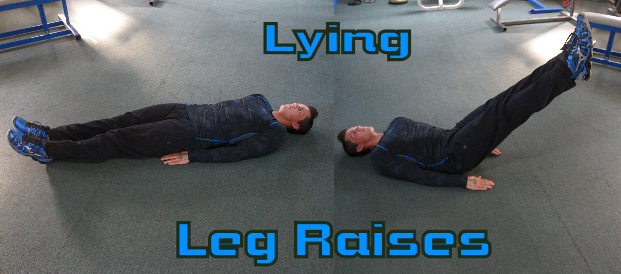
Lying leg raises: is a simple lower abdominal exercise and produces a great lower ab flexion it not only increases overall lower abdominal and lower back strength; but, also builds endurance in the core/midsection.
Keep in mind, best results produced with this exercise are accomplished by keeping your toes pointed forward, lower your legs far enough that you feel the stretch deep in the lower abs and some small stress in the lower back.
Try not to raise the legs too high as shown in the image, this keeps the abdominal's under tension.
If you're naturally strong at this exercise, add resistance with a dumbbell or book, just something between your toes, remember this is 'ab weight training' add resistance wherever you can. The abs are no different than any other muscle.
Rep range:10 to 12
Set range: 2 or 3
Mountain climbers
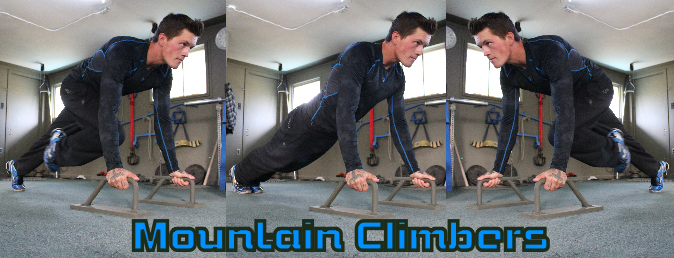
Mountain climbers: are a great way to strengthen the hip flexors and lower abs, the variation shown here is resting on elbows which means: there's a stronger crunching effect as the knees are brought towards the arms.
You can also perform these in a push-up style position, bring your knees up underneath you for a stronger, lower ab contraction.
Perform these alternating one leg at a time.
Rep range: 10 to 12 each leg.
Set range: 2
Planking

Planking is an easy exercise, if; you do them at the very end of all of your exercise sets when the muscles of the abdominal core and lower back are fatigued.
The idea is to hold a perfect straight line, (plank position). Use a mirror if you have to, to make sure that you don't have a sway in your back or that your butt is not pushed up beyond a perfectly straight line.
Once you're in a plank push-up position immediately imagine pulling your knees towards your abdomen , then hold a flexed contraction with your abdominal's counting to 10 or 12, and don't count quickly hold this contraction for the count.
Note: moving your shoulders forward and backwards a few inches holding the plank position, as your contracting the abdominal's will make this feeling even more intense.
2 sets counting to 10 or 12 will help strengthen the entire abdominal and lower back area.
Advanced AB Weight Training
At this level think - quality over quantity; the mental and physical depth of how you train your abdominal's should be revisited. This is a higher level of commitment, increasing resistance is all a part of this level.
Treat the abdominal's like any other body part, some hard work and exercise makes them grow in shape and density. You probably wouldn’t consider doing barbell bench presses for 50, 75 or 100 reps with no weight on the bar to build up bigger pectoral muscles?
Ab weight training is no different, choosing some of the more challenging exercises and adding resistance is nothing new, but...
If you’re trying hard to develop that six pack, adding resistance to increase even small growth to be noticed visually is very important in any decent ab routine.
Advanced AB Exercises:
Lower abdominal's and sides:
Weighted Twisting Knee-ups

Twisting Knee-ups: if you're not used to this exercise feel free to practice doing these without weight and just try twisting, if that is too much just use regular knee ups; where you position your knees straightforward-raising and lowering them.
Once you become conditioned, then try twisting and adding weight.
As you can see this exercise is performed with chain-weight by pulling to the side and simultaneously raising the knees as high as you can then lowering the legs, then raising and twisting to the opposite direction.
Rep range: if you're conditioned should be 6 to 8 for each side.
Set range: 2 because this exercise is a toughie, you don't need lots of sets.
Hanging straight leg raises

Hanging straight leg raises: if you cannot perform these in the beginning, try coming up to just parallel. As you become more conditioned try to get the legs up nice and high, this simply affords a stronger lower abdominal contraction.
Try to keep an overhand grip as you hang instead of; an underhand grip, which would allow the biceps to come into play and help too much.
Keep the toes pointing forward, legs as straight as you can, keeping your abdominal form tight effectively stresses the lower part of the core more intensely.
Rep range on this exercise: should be 8 to 10.
Set range: 2 to 3
Decline weighted leg raises

Decline weighted leg raises: these are shown here in the decline position, as opposed to performing them on the flat as in the beginner routine.Positioning a dumbbell, between your feet held tightly while supporting yourself on a decline board adds to the intensity of lower ab flexion.
(The dumbbell does not have to be very heavy in this exercise), toes pointed forward, legs straight - raise the legs so they're just short of 90° to your torso then lower.
Focus on keeping your abs flexed through the entire duration of the exercise, this again increases the intensity of this movement.
Rep range: 8 to 12
Set range: 2 to 3, performing lots of sets is not as effective as making the ones that you perform count, with intensity.
Upper abdominal's and sides
Barbell ab extensions

Barbell, AB extensions: this exercise is performed similarly to using an Ab-wheel, just with the barbell instead. if you're not strong enough in the beginning to perform this with plate weight on your shoulders, as shown here, then try performing them with your own body weight.
Starting position: overhand grip, shoulder width apart, hands extended as shown, 8 to 10 inches past shoulders (on the floor), this keeps tension on the abs. Roll-out slowly, keeping the control on the hands and knees. Roll-out as flat as you can, arms fully extended.
On returning to the starting position use the knees and some hip flexion, and less with the hands and arms. Focus as deeply as you can on keeping your abs constantly flexed throughout exercise movement.
Feel free to perform these as a drop set, if you wish. E.g. removing the plate weight from the shoulders, and immediately performing another set.
Rep range: 6 to 8 reps, if you're using heavy resistance 8 to 10 without resistance.
Set range: 1 to 2
Cable pulls (wood cutters)

Chopping wood: cable pulls, slightly mimic the wood chopping process: hence the name, this exercise is a great all-around mid-core, stimulator, the internal and external obliques lower back and rectus muscles, all reap great rewards from this exercise.
As shown above take at least a shoulder width stance if you have much resistance at the end of the cable. Keep the arms legs and upper torso as straight as you can (keep your hands in line with the cable pulley).
As with all advanced ab weight training exercises, keep form tight, flex midsection and sides throughout the entire exercise.
Rep range: resistance allow 8 -10 repetitions per side of this exercise.
Set range: 2 to 3
Rotational Dumbbell planks: These can be performed with dumbbells or even a book (at home,) held in your hand.

Dumbbell planking: these are a very dynamic exercise, they force you to keep the entire body, including the shoulders, legs, abdominal's, sides and lower back all flexed during performance. These are a great overall exercise, specifically helping tone and core strengthen.
If your conditioning is not good enough to perform with dumbbells, don't worry about it, try performing them without dumbbells, just using your hand and the weight of your arm this will be plenty in the beginning, if you're not used to them.
As shown above: keep a solid planking position with abs fully flex throughout the entire exercise. Feet should be close to shoulder width apart, raised up on toes.
With the leading hand, start with the dumbbell well under your torso moving it up towards and slightly above shoulder height, repeat until finished then complete opposite side.
Rep range: 8 to 10
Set range: 2
Abdominal stretching exercises

Dumbbell extensions: are also used for chest and shoulder development, but I also use them because: these really pull and stretch the abdominal wall and obliques as you lower the dumbbell behind.
The contracting effort of bringing the dumbbell back into the starting position greatly enhances contrast and sharpness of the upper abs and especially the obliques.
Choose a dumbbell, that will provide the right amount of resistance, starting position should be with dumbbell slightly out past the forehead, this does not allow the abs and arms to rest when you're off of the 90° position.
Lower the dumbbells slowly to feel a strong stretch in the shoulders and the abdominal's. This should put the dumbbell roughly level with your head, begin pulling the dumbbell back up slowly in a controlled manner (keeping the abs flexed), to the starting position.
Rep range: try to set resistance at 10 to 12
Set range: 2
Lying weighted crunches

Weighted crunches: Even though this is an older exercise it's still a great upper ab shaper, specifically: this ab weight training exercise adds a lot of detail and a deep central cut to the division of the upper abs.
Having the feet up on a bench or chair with plate weight across your chest, sets the tone for upper ab isolation, intensity is obviously added with plate weight across your chest.
Try to keep the shoulders off the floor as you start, pull up as high as you can keeping the abdominal wall flexed throughout the entire exercise.
Rep range: 10 to 12, so adjust weight resistance accordingly
Set range: 2
Ab weight training frequency:
Performing your ab weight training workouts two or possibly three times a week should give enough stimulation to produce new definition and growth.
Time duration of ab training, at an advanced level will probably take roughly 15-20 minutes if it’s intense.
Don’t make it easy on yourself: pick exercises and resistance that really works and challenge your abs, their a high density muscle, therefore very stubborn, but... they will give-in-when pushed.
Pick three or four exercises and perform them as a circuit, e.g., one after the other.
Taking little or no rest if possible between sets is the secret to seeing definition.
Summarizing ab weight training:
Start your ab weight training on the right foot: treat the abdominal's like any other group of muscles that you train regularly.
The core of the abdominal and lower back muscles act as a corset that adds protection, strength and support for the spinal column unifying hip and waist strength, where a lot of injuries can occur.
Everyone’s needs and wants are different: if you’re training your abs to strengthen or for injury prevention, using medium resistance that allows 10 to 12 repetitions and a set range per-workout of five or six. This should consist of half abdominal and lower back strength movements.
Performance specific for sports: this takes a different approach to ab weight training, more effort should be focused on 2-3 days per week, resistance and intensity level should be higher, (if abs are conditioned), 6 to 10 sets keeping rest times as short as possible.
Visual abdominal impact: even for looks, abdominal's and lower back, still need variety to support and stabilize body mechanics. Abdominal training frequency should be in the 3 - 4 days per week.
Range of resistance/weight should be mediated between medium and high. 5 to 8 sets per workout, rep range should be at least 10 to 12, depending on resistance levels.
I view the abdominal's as being special among all muscle groups; the rectus abdominal's, lower back, oblique’s and serratus muscles all work in unison targeting one area, affects the whole midsection corset of muscle, but...
Performing countless ab exercises with long rep ranges of over 25 are boring and probably will not show your core off as much as using resistance to build up the ab and lower back muscles.
If you find your mind is wandering while you’re training, then performance is not intensified enough, add more resistance, shorten the amount of total repetitions, sets and rest, change exercises, but stay focused.
You should feel your abs after most workouts, Fatigue/tenderness is common, but often followed by something even greater...
If you don’t give up, a beautiful set of abdominal's will emerge from your midsection.
DWT


